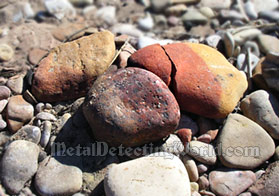Hot Rocks, page 4
Type II: POSITIVE Hot Rocks
General Info, + Mineral Salts and How To Eliminate Their False-Metallic Signals

Positive hot rocks are more conductive than the surrounding ground matrix, and their Ground Balance values are lower than the Ground Balance value of soil they are in. This is why they cause a metal detector to sound off with positive, sharp audible responses sounding like signals generated by good metallic targets in Motion Discriminate mode. And even small positive hot rocks can often be detected up several inches deep.
An iron oxide Maghemite - product of natural oxidation of Magnetite, is the most common mineral-constituent of the iron-bearing positive hot rocks. Maghemite (Fe2O3, γ-Fe2O3) is a member of the family of iron oxides. It has the same structure as Magnetite, but exhibits weaker ferrimagnetic properties than Magnetite. That is why the iron-bearing positive hot rocks are not always drawn to a magnet. They are most often reddish in color, like brick-red, but can also be black, brown or even yellow. The maghemite rocks are often small, lie on the surface, and are common in many gold prospecting regions.
Another troublesome category of positive hot rocks comprises rocks containing sulfide minerals such as the flame-colored Pyrrhotite (also called magnetic Pyrite, Fe(1-x)S (x = 0 to 0.2)) and Bornite (also known as peacock ore, Cu5FeS4) which has a brown to copper-red color on fresh surfaces, that tarnishes to various iridescent shades of blue to purple in places, hence the name "peacock ore".
Bornite is important as an ore for its copper content of about 63 percent by mass. Pyrrhotite does not have specific applications, and is mined primarily because it is associated with another sulfide mineral - pentlandite, that can contain significant amounts of nickel and cobalt. Both sulfides are conductive, and can sound just like gold nuggets, but the gold is not found in the same type of rock as the sulfide ores in many geological settings. Therefore, the detector's audio responses to the sulfide hot rocks can be ignored once such a rock can be identified.
Other types of the positive hot rocks are not iron-bearing and contain high concentrations of copper ore, aluminum (bauxite - the raw form of aluminum), manganese, nickel, cobalt, gold and graphite - a highly conductive carbon mineral. On some coin shooting and relic hunting sites, the positive hot rocks may be represented by red-clay bricks and stones from a fireplace or a campfire.
The less challenging category comprises hot rocks containing the above-mentioned graphite or graphitic slate rock, which generate very broad signals, do not sound like gold, and can not be tuned out by ground balancing. If a suspected rock-find generates a positive audio response, is black in color, and leaves black streaks on paper like a pencil, it is a graphitic hot rock. In order to use a metal detector in the graphite-bearing area, you will have to reduce the Sensitivity level.
Because the metal detector's false-metallic audio responses to the positive hot rocks do not have a distinct character of sound (except maybe the graphitic hot rocks) like the audio responses to negative hot rocks, the positive hot-rock signals are hard to distinguish from audio responses to real non-ferrous targets, both high- and low-conductive, like coins and gold nuggets respectively. This is why the positive hot rocks have been considered a real nuisance to many detectorists, especially gold nugget and meteorite hunters, for years.
And in the hot-rock-infested areas with intensely high mineralization, the positive hot rocks can be a real challenge to deal with and extremely frustrating for those gold nugget hunters who do not use advanced metal detectors. The highly mineralized ground causes these detectors respond with so much noise that it is nearly impossible to discern gold-nugget signals among the signals of the hot rocks which may sound exactly like a gold nugget. Even users of the most advanced metal detectors have to practice a lot in order to learn how to "to separate the wheat from the chaff" (see next page).
Mineral Salts and How To Eliminate Their False-Metallic Signals Using Negative Offset of Ground Balance
Besides the positive hot rocks, concentrations of mineral salts in moist soil also cause high levels of conductive mineralization, and, like the hot rocks, can often generate positive or false-metallic signals.
Common causes are the following:
- 1) spots where natural mineral salts have been concentrated by evaporation;
- 2) the spontaneously occurring "pockets" of mineral fertilizer (inorganic);
- 3) spots with organic fertilizer like "cow pies" and urine from livestock;
- 4) concentrations of residue from de-icing salts;
- These mineral-salt concentrations are "dormant" when completely dry, but can be easily "activated" by rains. Along with sea salt, mineral salts comprise another type of Conductive Mineralization - wet salts.
Just like in a case of dealing with "pockets" of sea salt in wet sand during coastal Beach Hunting, you can easily eliminate or reduce the detector's false-metallic audio responses to the wet mineral salts by applying a Negative Offset to your Non-Silent Search detector's Ground Balance. Ground balancing must be done at the iron-free, mineral-deposit-free and hot-rock-free ground spot.
Provided the mineral salts in a search area are within the Ground Balance range of your detector's ability to compensate them, adjust the Ground balance control until a slight null in audio Threshold is heard as the search coil is lowered to the ground. This will lessen the positive effect of the conductive ground, and muffle, if not eliminate, most false signals generated by the wet-salt concentrations.